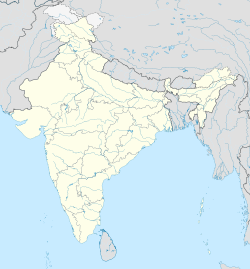Bareilly
| Bareilly बरेली |
||
|---|---|---|
|
|
||
| State : |
|
|
| State : | Uttar Pradesh | |
| District : | Bareilly | |
| Location : | 28 ° 22 ′ N , 79 ° 25 ′ E | |
| Height : | 177 m | |
| Residents : | 903,668 (2011) | |
| Website : | Bareilly | |
| Ahichchhatra fortress | ||
Bareilly ( Hindi : बरेली , Urdu : باریلی; Barelī [ bʌˈreːli ]) is a city in the Indian state of Uttar Pradesh with about 900,000 inhabitants (2011 census). Bareilly is the capital of Bareilly District and the Bareilly Division .
location
The city is located in the area of Rohilkhand , part of the extremely fertile Avadh (or Oudh ) region in the northern Ganges plain on the Ramganga River at an altitude of about 177 m . The distances to Lucknow , the capital of Uttar Pradesh, or to Delhi are around 260 km to the south-east and west, respectively.
population
About 58.5% of the population are Hindus and about 38.5% are Muslims ; the remaining 3% are distributed among other religions ( Jains , Sikhs , Buddhists , Christians). The male proportion of the population exceeds (as is common in northern India) the female by more than 10%.
economy
Bareilly is a center of furniture manufacturing and trading in cotton, grain and sugar. The Saraswati Camphor Factory, one of the largest camphor producers in Asia, is located in Bareilly's industrial center Parsakhera .
history
The region around Bareilly ( Panchala ) is already mentioned in the Mahabharata ; it is connected to the legends of the princess Draupadi . Even Buddha and Jain - Tirthankara Parshvanatha are the old fort during their migration to the north of India Ahichchhatra have visited. Since the 13th century, the area belonged to the Sultanate of Delhi , which was conquered in the First Battle of Panipat (1526) by Babur , the leader of the Mughals . The founding date of today's city is 1537; its expansion took place in large parts, however, only built in the 17th century under the governor ( subahdar ) Makrand Ray . Bareilly later became the capital of the Rohillas , an immigrant clan who took control of the surrounding area. In 1774 the ruler of Avadh conquered the area with the help of the British; the city was ceded to the British in 1801. During the Indian uprising of 1857-58 Bareilly was the headquarters of the insurgents in Rohilkhand until it was snatched from them on May 6 and 7, 1858 by General Colin Campbell .
Attractions
Four locally and regionally significant Shiva temples (nath temples) form the former city limits. The Friday Mosque (Shia Jama Masjid) is the religious center of Muslims . Several Gurudwaras of the Sikh religion and several Christian churches can also be found throughout the city.



